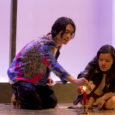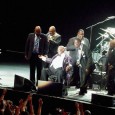“Exit in case of Brahms.”
This was plastered on the walls in the venue of the premiere of Brahms’ 1st symphony.
We had no need of this exhortation on the account given by The Metropolitan Orchestra at Balmain Town Hall. Here was robust, inspired playing directed with consummate aplomb by musical director Sarah-Grace Williams.
More on the Brahms, but we started in Rossini’s Parisian salon with Saint-Saëns’s Tarantella. I wondered if Rossini had a spider charmer on hand as the title suggests the dance after being bitten.
The scoring allowed lucid contributions from the strings and low winds. Two soloists, Svetlana Yaraslavskaya (flute) and David Rowden (clarinet) matched and complemented each other with brisk florid passages.
The balance worked particularly well with the ensemble, again at the direction of Williams.
When the dance gained momentum, and the venom spread through the body, perfect ensemble prevailed. This was the appetiser before the deeply evocative work that followed.
Across the English Channel but with inspiration from Ravel, Vaughan Williams’ “Fantasia on a Theme of Thomas Tallis” calls back to the Tudor plainchant and forward to filmic music of today.
Here every string player contributed to a sonorous account of the piece, rich with autumnal colours.
One thing you can’t enjoy from the comfort of your lounge – two young boys sitting in front of me were trying to work out where the second string orchestra was. One pointed to his right; the other pointed below. A friend sitting across from them with his chair at 45 degrees could hear their discussion.
“They’re there,” he pointed to the back of the hall.
Sincere acknowledgment of the keen balance and cohesion of the two orchestras should be noted. Time changes, tonality shifts all clearly indicated by the other Williams, Sarah-Grace.
Tremendous intensity in concentration kept the audience in thrall.
At the first performance on July 21, 18-year-old Herbert Howells described the work and the atmosphere in the audience as “electric”.
So, back to Brahms and his Serenade in D, Opus 11.
Clearly this is symphonic repertoire, and marks The Metropolitan Orchestra as having successfully transitioned from chamber orchestra. Redolent of Beethoven, the players thrived on making a bold tutti in the opening Allegro molto.
Perhaps the acoustics cloud the timpani at times, but otherwise there was satisfying string and wind sonority, accompanying the horns, well led by Julia Zeltzer.
If there was a moment of exposed playing which lacked the fluidity of the outer movements, it was in the Adagio non troppo, and maybe this movement will benefit from several readings. Rehearsal was clearly evident with the rest.
Wintry sun shone through the G major Menuet. Again fine solos from the upper winds. Perhaps a little more oboe would have given this section more piquancy.
A rousing Rondo brought the finale of the concert, and gave a sense of the orchestra’s confidence in playing solid Romantic music.
Is Brahms fourth racket to follow? Let’s hope so.





